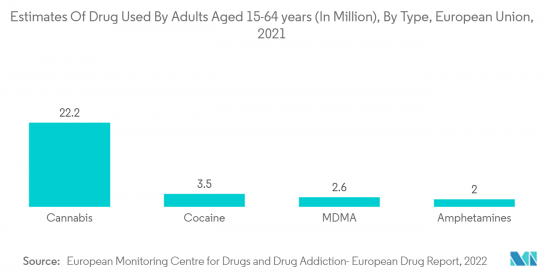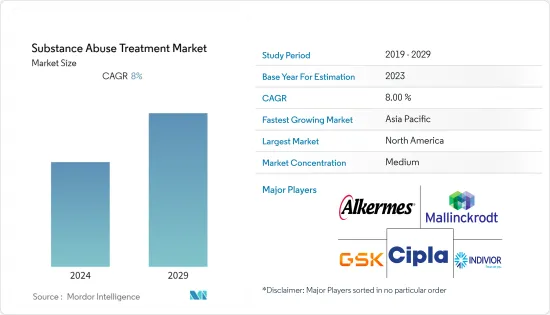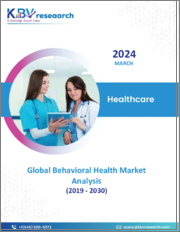
|
시장보고서
상품코드
1405368
세계 약물 남용 치료 시장 : 점유율 분석, 산업 동향과 통계 및 성장 예측(2024년-2029년)Substance Abuse Treatment - Market Share Analysis, Industry Trends & Statistics, Growth Forecasts 2024 - 2029 |
||||||
약물 남용 치료 시장은 예측 기간 동안 복합 연간 성장률(CAGR) 8.0%를 나타낼 것으로 예상됩니다.
유행병에서의 봉쇄 및 제한으로 인해 약물 중독과 알코올 중독 환자를 포함한 COVID 및 응급 상태가 없는 상태의 진단 및 치료가 취소되거나 지연되었습니다. 예를 들어, 2021년 11월에 JAMA Network에 발표된 연구에서 미국에서는 COVID-19 팬데믹기간 동안 연방 및 주 정부가 오피오이드 사용 장애(OUD) 치료에 대한 액세스를 제공하기 위한 임시 전략 실시했다고 말합니다. 이 연구는 또한 미국의 모든 주와 워싱턴 DC가 새로운 환자의 OUD 치료에 대한 접근을 개선하기 위해 적어도 하나의 원격 의료 정책을 채택했다고 말합니다. 이와 같이 COVID-19의 유행이 계속되는 가운데, 약물 남용 치료에 대한 수요가 증가하고 있었습니다. 유행 이후 COVID-19 환자 수는 점차 감소하고 시장은 정상 속도로 성장했습니다. 이런 식으로 COVID-19의 유행은 이전 단계 시장 성장에 완만한 영향을 미쳤습니다. 또한, 세계적으로 약물 남용 치료에 대한 수요가 증가하고 있기 때문에 시장은 안정적인 속도로 더 성장할 것으로 예상됩니다.
또한 약물 남용 치료 시장은 약물에 대한 의식 향상 캠페인과 예방 프로그램 증가, 인구 중독자 수 증가에 의해 성장할 것으로 예상됩니다.
약물 남용, 약물 중독, 예방 및 관리에 대한 의식 증가와 민간 및 공공 기관의 지원으로 약물 남용 치료에 대한 수요가 높아질 것으로 예상됩니다. 예를 들어, 2021년 12월 인도 정부는 약물이 없는 인도 캠페인을 시작하고 인도 국민의 약물 남용을 억제하기 위한 지시를 내렸습니다. 마찬가지로 2021년 10월 미국 질병 예방관리센터(CDC)는 약물의 과다 복용으로 인한 사망을 예방하기 위해 18-34세의 청소년 성인을 대상으로 하는 4가지 보완 교육 캠페인을 시작 했습니다. 이 캠페인은 펜타닐의 만연과 위험성, 약물 혼합의 위험과 결과, 나록손의 구명 효과, 치료 및 회복을 돕기 위해 약물 사용과 관련된 스티그마를 감소시키는 중요성에 대한 정보를 제공합니다. 이러한 캠페인과 이니셔티브는 약물 중독자들 사이에서 약물 남용 치료에 대한 인식을 높이고 시장 성장에 기여합니다.
또한, 약물 남용 치료에서 시장 진출기업의 주요 발전이 시장 성장을 뒷받침할 것으로 예상됩니다. 예를 들어, 2021년 6월 INDIVIOR PLC와 AELIS FARMA는 대마 유발성 정신병(CIP)을 포함한 대마초 사용 장애(CUD)의 심각한 영향에 대처하기 위한 전략적 파트너십과 옵션 라이선스 계약을 발표했습니다. 또한 2021년 5월 JB Chemicals &Pharmaceuticals Ltd(JBCPL)는 세계 금연 데이에 360개의 금연 이니셔티브의 일환으로 담배를 소비하는 충동을 억제하는 데 도움이 되는 노스모크 처방약용 니코틴 사탕을 출시했습니다.
따라서 약물에 대한 의식이 높아지고 시장 진출기업에 의한 주요 발전 등 성장 요인에 따라 조사 대상 시장은 분석 기간 동안 성장을 이룰 것으로 예상됩니다. 그러나, 치료에 대한 접근과 행동 치료의 중단에 대한 개인의 소극성과 일부 국가에서의 치료 컴플라이언스의 낮음은 시장 성장을 방해할 수 있습니다.
물질 남용 치료 시장 동향
담배/니코틴 중독 치료 분야는 예측 기간 동안 상당한 성장이 예상된다.
치료 유형별로는 담배/니코틴 중독 치료 분야가 유리한 성장을 이룰 것으로 예측됩니다. 담배/니코틴 중독 치료에는 담배와 니코틴에 대한 중독을 억제하기 위한 약물 요법과 대체 요법이 포함됩니다. 세계보건기구(WHO)가 언급한 바와 같이, 담배와 그 소비 및 흡연에 의한 사용은 유해하고, 세계적으로 그 사용자의 절반이 사망하고 있습니다. 2022년 5월 WHO는 담배가 매년 800만 명 이상의 생명을 빼앗고 있다고 발표했습니다. 700만명 이상의 사인은 담배의 직접적인 사용으로 인한 것으로, 120만명 이상의 비흡연자가 부류연기에 노출되어 생명을 떨어뜨리고 있습니다. 이러한 엄청난 수의 담배 사용자와 담배 중독으로 인한 피해는 담배/ 니코틴 중독 치료에 대한 수요를 높이고이 분야의 성장을 뒷받침할 것으로 예상됩니다.
또한 일부 시장 진출 기업들은 임상시험 중 금연요법과 치료를 통해 담배/니코틴 중독 치료제 개발을 추진하고 있습니다. 예를 들어, NFL Biosciences는 2021년 12월 금연 치료제 NFL-101의 효능과 안전성을 평가하는 2/III상 임상시험을 시작했습니다. 이 시험은 2021년 6월 호주 인간 연구 윤리 위원회(HREC), 2021년 9월 프랑스 의약품 및 건강 제품 안전청(ANSM)에서 승인되었습니다. 마찬가지로 2021년 9월 Mydecine Innovations Group은 존스 홉킨스 대학의 연구 기관과의 5년간의 협력에 관한 최근 발표에 이어 MYCO-001 화합물의 금연을 대상으로 하는 2/3상 임상시험 시작했습니다. MYCO-001 화합물은 니코틴 중독의 치료를 목적으로 합니다. 이러한 활발한 임상시험은 담배/니코틴 중독의 치료제나 치료법 시장 진입에 길을 열어, 이 분야의 성장을 더욱 뒷받침할 것으로 보입니다.
따라서 담배/니코틴 중독 치료 분야는 담배 이용자의 많음과 담배/니코틴 중독 치료법의 활발한 임상시험 등 위의 요인에 의해 예측기간 동안 큰 성장을 보일 것으로 예상됩니다.

북미는 예측기간 중 상당한 성장이 예상된다.
북미의 약물 남용 치료 시장은 담배 남용이 증가하고 약물 남용을 줄이기위한 정부의 이니셔티브이 증가하고 있기 때문에 예측 기간 동안 크게 성장할 것으로 예상됩니다. 예를 들어 SAMHSA(Substance Abuse and Mental Health Services Administration)가 2021년에 발표한 데이터에 따르면 미국에서는 12세 이상의 61,203명 이상이 불법 약물을 섭취한 것으로 보고되었습니다. 또한 캐나다 정신위생협회(CMHA)가 발표한 데이터에 따르면 캐나다 인구의 21% 이상(600만 명 이상)이 평생 약물 중독 기준을 충족할 것으로 추정됩니다. 이러한 중독 환자 증가는 중독 치료에 대한 수요를 증가시키고, 따라서 이 지역 시장 성장을 가속할 것으로 예상됩니다.

또한 미국 정부는 미국인의 약물 남용의 증상을 모니터링하고 판단하기 위해 다양한 노력과 자금 지원을 실시했습니다. 예를 들어, 2022년 2월 최신 정보에 따르면, 텍사스와 그 가장 큰 카운티 중 일부는 주요 제약 유통 회사 3개사의 전국 화해의 일환으로 오피오이드 구제 기금으로 11억 7,000만 달러를 받았습니다. 게다가 2022년 2월, 미국 보건 복지성은 물질 남용 및 정신 보건 서비스국(SAMHSA)의 보조금 프로그램으로서, 물질 사용의 영향을 받고 있는 임산부와 아이의 건강 요구에 대처하는 1,000만 달러를 발표 했습니다. 이러한 프로그램은 미국에서 약물 남용 치료 수요를 촉진하고 북미 시장 성장을 가속할 것으로 예상됩니다.
또한, 약물 남용 치료에서 시장 진출기업의 주요 발전이 이 지역 시장 성장을 뒷받침할 것으로 예상됩니다. 예를 들어, 2022년 8월, B.More Inc.는 알코올 사용 장애(AUD)를 관리하기 위한 합성 실로시빈(SYNP-101)의 시험 신약(IND) 신청에 대해 USFDA의 승인을 받았습니다. 또한 2022년 1월, ANANDA Scientific Inc.는 회사의 의약품인 Nantheia ATL5의 임상시험 평가에 관한 IND 신청에 대해 USFDA의 승인을 받았습니다. Nantheia ATL5는 ANANDA의 독점적 인 약물 전달 기술로 칸나 비디올(CBD)을 사용하는 연구 약물로 오피오이드 사용 장애의 보조 치료제로 사용하기위한 것입니다. 이 시험은 미국 캘리포니아 로스 앤젤레스 대학의 Jane and Terry Semel Institute for Neuroscience and Human Behavior에서 실시됩니다.
따라서 높은 약물 중독, 탈중독 이니셔티브 및 주요 기업의 주요 발전을 포함한 앞서 언급한 요인들 덕분에 조사된 시장은 북미에서 더 성장할 것으로 예상됩니다.
약물 남용 치료 산업 개요
약물 남용 치료 시장은 세계적 및 지역적으로 사업을 전개하는 기업이 복수 존재하기 때문에 그 성질상 경쟁이 치열합니다. 이 시장에서 사업을 전개하는 주요 기업으로는 Alkermes PLC, Mallinckrodt LLC, Cipla Ltd, GlaxoSmithKline PLC, Indivior PLC 등이 있습니다.
기타 혜택:
- 엑셀 형식 시장 예측(ME) 시트
- 3개월간의 애널리스트 서포트
목차
제1장 서론
- 조사의 전제조건과 시장 정의
- 조사 범위
제2장 조사 방법
제3장 주요 요약
제4장 시장 역학
- 시장 개요
- 시장 성장 촉진요인
- 약물 의식 향상 캠페인과 예방 프로그램 증가
- 중독 인구 증가
- 시장 성장 억제요인
- 치료에의 접근에 대한 개인의 소극성과 행동 치료의 중단
- 일부 국가에서의 치료 컴플라이언스의 낮음
- Porter's Five Forces 분석
- 신규 참가업체의 위협
- 구매자/소비자의 협상력
- 공급기업의 협상력
- 대체품의 위협
- 경쟁 기업간 경쟁 관계의 강도
제5장 시장 세분화(시장 규모-100만 달러)
- 치료 유형별
- 알코올 중독 치료
- 담배/니코틴 중독 치료
- 약물 남용 치료
- 기타 치료 유형
- 유통 채널별
- 병원 약국
- 소매 약국
- 기타 유통 채널
- 지역별
- 북미
- 미국
- 캐나다
- 멕시코
- 유럽
- 독일
- 영국
- 프랑스
- 이탈리아
- 스페인
- 기타 유럽
- 아시아태평양
- 중국
- 일본
- 인도
- 호주
- 한국
- 기타 아시아태평양
- 중동 및 아프리카
- GCC 국가
- 남아프리카
- 기타 중동 및 아프리카
- 남미
- 브라질
- 아르헨티나
- 기타 남미
- 북미
제6장 경쟁 구도
- 기업 프로파일
- Alkermes PLC
- Cipla Ltd
- GlaxoSmithKline PLC
- Mallinckrodt LLC
- Indivior PLC
- Pfizer Inc.
- Teva Pharmaceutical Industries Ltd
- Orexo AB
- Apotex
- Opiant Pharmaceuticals Inc.
- Apotex
- BioCorRx Inc.
- Opiant Pharmaceuticals Inc.
- Purdue Pharma LP
- Novartis AG(Sandoz)
제7장 시장 기회와 앞으로의 동향
BJH 24.01.26
The substance abuse treatment market is expected to register a CAGR of 8.0% over the forecast period.
The lockdown and restrictions amid the pandemic canceled or delayed the diagnosis and treatment of non-COVID and non-urgent medical conditions including substance-addicted and alcohol-addicted patients. For instance, a study published in the JAMA Network in November 2021 stated that federal and state governments implemented temporary strategies for providing access to opioid use disorder (OUD) treatment during the COVID-19 pandemic, in the United States. The study further stated that all the states and Washington, DC of the United States adopted at least one telehealth policy to improvise access to OUD treatment for new patients. Thus, there was anan increase in demand for substance abuse treatment amid the ongoing COVID-19 pandemic. Although in the post-pandemic, numbers of COVID-19 patients decreased gradually which led the market to grow at a normal pace. Thus, the COVID-19 outbreak had a moderately impacted the market's growth in its preliminary phase. Moreover, the market is expected to grow further at a stable pace with the increasing demand for the susbtance abuse treatment, globally.
Further, the substance abuse treatment market is expected to grow with the rising drug awareness campaigns and prevention programs and growth in the number of addictions among the population.
The rising awareness of substance abuse, drug addiction and their prevention and management with the support of private and public bodies are expected to create more demand for substance abuse treatment. For instance, in December 2021, the Indian government launched the "Drug-Free India" campaign and issued directions for curbing drug abuse in the Indian populace. Likewise, in October 2021, the Centers for Disease Control and Prevention (CDC) launched four complementary education campaigns intended to reach young adults ages 18-34 years aimed at preventing drug overdose deaths. The campaigns provide information about the prevalence and dangers of fentanyl, the risks and consequences of mixing drugs, the life-saving power of naloxone, and the importance of reducing the stigma around drug use to support treatment and recovery. Such campaigns and initiatives are increasing awareness regarding substance abuse treatment among the addicted population, thereby contributing to the market's growth.
Furthermore, the key developments by the market players in substance abuse treatment are expected to boost market growth. For instance, in June 2021, INDIVIOR PLC and AELIS FARMA announced a strategic partnership and option-license agreement to address the significant repercussions of cannabis use disorders (CUD), including cannabis-induced psychosis (CIP). Further, in May 2021, JB Chemicals & Pharmaceuticals Ltd (JBCPL) launched NOSMOK prescription medicated nicotine lozenges as part of a 360 Tobacco Cessation initiative on 'World No Tobacco Day' that will aid in reducing the urge to consume tobacco.
Therefore, with the growth factors such as rising drug awareness, and the key developments by the market players, the studied market is anticipated to witness growth over the analysis period. However, the reluctance of individuals for accessing treatment and discontinuation of behavioral therapies, and poor treatment compliance in some countries are likely to impede the market growth.
Substance Abuse Treatment Market Trends
Tobacco/Nicotine Addiction Treatment Segment is Expected to Witness Significant Growth Over the Forecast Period
By treatment type, the tobacco/nicotine addiction treatment segment is anticipated to witness lucrative growth. Tobacco/nicotine addiction treatment includes pharmacotherapies and replacement therapies to curb the addiction to tobacco and nicotine. Tobacco and its usage through consumption and smoking are harmful, as they kill half of its users globally, as stated by the World Health Organization (WHO). In May 2022, WHO stated that tobacco claims the lives of more than 8 million people every year. More than 7 million deaths are caused by direct tobacco use, and over 1.2 million non-smokers lose their lives due to exposure to second-hand smoke. Such a vast number of tobacco users and damage caused by tobacco addiction is anticipated to boost the demand for Tobacco/nicotine addiction treatment which would bolster the growth of the segment.
Furthermore, several market players are engaged in advancing their offerings for tobacco/nicotine deaddiction with their smoking cessation therapies and treatment which are undergoing clinical trials. For instance, in December 2021, NFL Biosciences launched the Phase II/III clinical trial to assess the efficacy and safety of its NFL-101 smoking cessation treatment. It was approved by the Human Research Ethics Committee (HREC) in Australia in June 2021, and by the French National Agency for the Safety of Medicines and Health Products (ANSM), in September 2021. Similarly, in September 2021, Mydecine Innovations Group launched a Phase 2/3 clinical trial for smoking cessation for its MYCO-001 compound, following up on its recent announcement of 5-year cooperation with Johns Hopkins University's research institute. MYCO-001 compound is inteneded for treatment of nicotine addiction. Such active clinical trials would pave way for the market entry of these tobacco/nicotine addiction treatments or therapies which would further boost the growth of the segment.
Therefore, the tobacco/nicotine addiction treatment segment is expected to witness significant growth over the forecast period due to the abovementioned factors, including the high numbers of tobacco users and the active clinical trials of tobacco/nicotine addiction therapies.

North America is Expected to Witness Significant Growth Over the Forecast Period
The substance abuse treatment market in North America is expected to grow significantly during the forecast period with increasing overuse of tobacco and an increasing number of government initiatives aimed at reducing substance abuse. For instance, as per the data published by the Substance Abuse and Mental Health Services Administration (SAMHSA) in 2021, over 61,203 people aged 12 years and above were reported to have consumed illicit drugs in the year 2021, in the United States. Further, according to the data published by the Canadian Mental Health Association (CMHA), it was estimated that over 21% (over 6 million Canadian individuals) of the Canadian population would meet the criteria for drug addiction in their life. Such a prevalent addiction population within the country is anticipated to create more demand for addiction treatments, in turn, driving the market growth in the region.
Furthermore, various initiatives and funding are being implemented by the United States government to monitor the symptoms and determine drug abuse among the American population. For instance, as per a February 2022 update, Texas and some of its largest counties received USD 1.17 billion as an opioid relief fund as part of a nationwide settlement from three large pharmaceutical distribution companies. Moreover, in February 2022, the United States Department of Human Health and Services announced a USD 10 million Substance Abuse and Mental Health Services Administration (SAMHSA) grant program addressing the health needs of pregnant women and children affected by substance use. Such programs are anticipated to drive the demand for substance abuse treatment in the United States, thereby driving market growth in the North American region.
Additionally, the key developments by the market players in substance abuse treatment are expected to boost market growth in the region. For instance, in August 2022, B.More Inc. received the USFDA approval for its Investigational New Drug (IND) application for its synthetic psilocybin (SYNP-101) which is intended for the management of the alcohol use disorder (AUD). Further, in January 2022, ANANDA Scientific Inc. received USFDA approval for its IND application for the clinical trial evaluation of its drug, Nantheia ATL5. Nantheia ATL5 is an investigational drug that uses cannabidiol (CBD) in ANANDA's proprietary delivery technology and is intended to be used as an adjunctive treatment for opioid use disorder. The study would be done at the Jane and Terry Semel Institute for Neuroscience and Human Behavior at the University of California, Los Angeles, the United States.
Therefore, owing to the aforesaid factors, including the high drug addictions, de-addiction initiatives and key developments by the key players, the studied market is anticipated to grow further in the North America Region.
Substance Abuse Treatment Industry Overview
The substance abuse treatment market is competitive in nature due to the presence of several companies operating globally as well as regionally. The key players operating in the market include Alkermes PLC, Mallinckrodt LLC, Cipla Ltd, GlaxoSmithKline PLC, and Indivior PLC.
Additional Benefits:
- The market estimate (ME) sheet in Excel format
- 3 months of analyst support
TABLE OF CONTENTS
1 INTRODUCTION
- 1.1 Study Assumptions and Market Definition
- 1.2 Scope of the Study
2 RESEARCH METHODOLOGY
3 EXECUTIVE SUMMARY
4 MARKET DYNAMICS
- 4.1 Market Overview
- 4.2 Market Drivers
- 4.2.1 Rising Drug Awareness Campaigns and Prevention Programs
- 4.2.2 High Number of Addicted Population
- 4.3 Market Restraints
- 4.3.1 Reluctance of Individuals for Accessing Treatment and Discontinuation of the Behavioral Therapies
- 4.3.2 Poor Treatment Compliance in Some Countries
- 4.4 Porter's Five Forces Analysis
- 4.4.1 Threat of New Entrants
- 4.4.2 Bargaining Power of Buyers/Consumers
- 4.4.3 Bargaining Power of Suppliers
- 4.4.4 Threat of Substitute Products
- 4.4.5 Intensity of Competitive Rivalry
5 MARKET SEGMENTATION (Market Size by Value - USD million)
- 5.1 By Treatment Type
- 5.1.1 Alcohol Addiction Treatment
- 5.1.2 Tobacco/Nicotine Addiction Treatment
- 5.1.3 Drug Abuse Treatment
- 5.1.4 Other Treatment Types
- 5.2 By Distribution Channel
- 5.2.1 Hospital Pharmacies
- 5.2.2 Retail Pharmacies
- 5.2.3 Other Distribution Channels
- 5.3 Geography
- 5.3.1 North America
- 5.3.1.1 United States
- 5.3.1.2 Canada
- 5.3.1.3 Mexico
- 5.3.2 Europe
- 5.3.2.1 Germany
- 5.3.2.2 United Kingdom
- 5.3.2.3 France
- 5.3.2.4 Italy
- 5.3.2.5 Spain
- 5.3.2.6 Rest of Europe
- 5.3.3 Asia-Pacific
- 5.3.3.1 China
- 5.3.3.2 Japan
- 5.3.3.3 India
- 5.3.3.4 Australia
- 5.3.3.5 South Korea
- 5.3.3.6 Rest of Asia-Pacific
- 5.3.4 Middle East and Africa
- 5.3.4.1 GCC
- 5.3.4.2 South Africa
- 5.3.4.3 Rest of Middle East and Africa
- 5.3.5 South America
- 5.3.5.1 Brazil
- 5.3.5.2 Argentina
- 5.3.5.3 Rest of South America
- 5.3.1 North America
6 COMPETITIVE LANDSCAPE
- 6.1 Company Profiles
- 6.1.1 Alkermes PLC
- 6.1.2 Cipla Ltd
- 6.1.3 GlaxoSmithKline PLC
- 6.1.4 Mallinckrodt LLC
- 6.1.5 Indivior PLC
- 6.1.6 Pfizer Inc.
- 6.1.7 Teva Pharmaceutical Industries Ltd
- 6.1.8 Orexo AB
- 6.1.9 Apotex
- 6.1.10 Opiant Pharmaceuticals Inc.
- 6.1.11 Apotex
- 6.1.12 BioCorRx Inc.
- 6.1.13 Opiant Pharmaceuticals Inc.
- 6.1.14 Purdue Pharma LP
- 6.1.15 Novartis AG (Sandoz)















